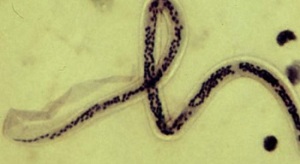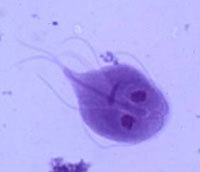
Parasites in biology are considered organisms that perform their life at the cost of another organism of another biological species.
Such vital activity of the parasite does not bring any benefits to the host organism and at best, the interaction does not lead to the development of negative effects.
Worst is the parasite that causes the death of the host. In this case, either the parasite escapes to the outside environment, or dies collectively.
The diseases caused by human parasites have been known in fact since the primitive times of human existence. This fact is established during observing the behavior of the direct human ancestor - the ape. The woolly parasites were discovered and eliminated by monkeys. This process is very socially interactive.
Human intolerance to the appearance of blemishes and skin holes also dates back to the early days of human existence. Some parasitic insects in tropical regions can lay their larvae on the skin. This results in a reflex that pushes them out of the skin.
Various types of worms that affect the eyes, skin and digestive tract have been described by ancient scientists. In the 18-19 century, with the development and introduction of microscopes into medical practice, scientists have identified the causes and ways of transmission of the parasites that can cause specific diseases inpeople.
- Early 20th century and discovery of anti-parasitic agents enabled man to withstand most parasitic diseases.
Therefore, humans coexist closely with many different types of parasites throughout its history. However, modern medical science allows to diagnose the entire parasite spectrum quickly and quite accurately, giving doctors the opportunity to treat these diseases in the shortest possible time and with minimal risk. risk for the patient.
The general practitioner will help identify the parasite in the human body, its symptoms and treatment. Sometimes infectious disease specialists of a more narrow discipline - parasiticians - may be involved.
What is a parasitic disease?

Parasitic diseases are diseases that arise after the introduction (entry) of biological agents into the body. The latter are known as human parasites. Symptoms of such diseases are extremely diverse and depend precisely on the invading agent and its live activity in the body.
In the way that parasites affect the human body, it is common to divide them into the following groups:
- Exogenously affects human skin and hair.
- Toxic effects of parasitic wastes on the body.
- Damage to the mucous membranes of the digestive tract and lungs caused by parasites.
- Formation of cysts and cysts in human organs. An increase in the size of such cysts and cysts leads to specific symptoms of organ compression.
- Interrupts the normal transport of food through the digestive tract. This can lead to intussusception (often occurring in children) or the development of intestinal obstruction.
- Parasites that live inside humans can cause hypersensitivity and nonspecific allergic reactions.
- Microorganisms can disrupt the functioning of blood cells, causing fever and intoxication.
- The effects of certain types of parasites on the body not only lead to severe symptoms, but also to visceral failure or death.
Many such negative effects from parasites arise in the body due to the introduction of various biological species into human organs. However, the biological diversity of parasites that live in the human body allows doctors to identify specific signs of parasitic diseases.
Parasites that live in the human body

The main ways of infecting human parasites depend on the life cycle of the biological organism, which is the parasitic pathogen.
Doctors determine the ways parasites get into people are:
- Contact link.This is a feature of insect parasites, as well as some helminths that live mainly in water, their larvae penetrate under the human skin. You can be infected this way both from the sick person and through contaminated linens, beds, toiletries, etc. v.
- Fecal-oral routeof infection. Occurs when pathogenic cysts get into food after coming into contact with infected feces, mainly from animals. Self-invasive processes can also be observed - self-infecting a person without personal hygiene, etc. v.
- Pollution.Germs get into the bloodstream when the infected insect is crushed.
- Contagious infection.The parasite enters the bloodstream when bitten by a carrier insect. Often times, this path of transmission is typical for the simplest of parasites, for example, malaria.
- Sexually transmitted infection.This is typical of both sexually transmitted diseases caused by parasites and certain types of helminths that can affect the urinary tract and genitals of humans.
Protozoa, helminths (nematodes and flatworms), insects, as well as some fungi are believed to be responsible for parasitic diseases.
The appearance of humans to these species depends on geographic area and climate. Therefore, each country's medicine keeps its own records and lists of parasites that are specific to that country.
The biological organisms that enter the human body have been studied in detail by medical biologists and doctors, which clearly classifies all organisms that can cause parasitic diseases:
- The simplest organisms (filariasis, roundworm disease, babeosis, Chagas disease, leishmaniasis, malaria, giardiasis, filariasis, toxoplasmosis, trichomoniasis).
- Worms. The term helminthiasis is sometimes used (roundworm, filariasis, filariasis, filariasis, filariasis, oculariasis, strongyloidiasis, teniasis, hepatocellular fluke, schistosomiasis, intestinal helminthiasis, leukemia).
- Exogenous (lice (pubic, head, clothing), demodicosis, flea, tick, scabies).
Signs of parasites in the human body

Unfortunately, there are no exact signs of the parasite in the human body and there are no symptoms indicating this type of parasitic infection or that parasite. This leads to the fact that for an accurate diagnosis, for example, helminthiasis, specific tests are required.
On the other hand, almost all external infections are diagnosed quite simply - based on the clinical picture and the presence of a certain insect on the skin.
In general, all the symptoms of parasitic diseases can be grouped into the following groups:
- Skin itching and discomfort caused by skin and hair parasites (fleas, lice and others). Skin rashes that look like acne and itch are often related to a condition like demodicosis (a special type of tick).
- Pain in different parts of the body caused by the parasite entering the skin and muscles (some worms live in water).
- Eye pain, blurred vision.
- Pain in the lungs, cough with sputum (this may be typical of the movement of roundworm larvae in the lungs, as well as with lung follicles, etc. ).
- Nausea, vomiting, and diarrhea are very common symptoms of most gastrointestinal helminths.
- Jaundice, liver and biliary disorders, liver failure. These symptoms occur with helminthiasis that affect the liver and bile ducts, as well as with malaria at its peak.
- Stomach pain.
- Intestinal obstruction caused by a closed loop of the intestine with a large number of roundworms or a large representative of the flatworm.
All symptoms of the presence of parasites in the human body, in the absence of data for another pathology, will make the doctor think of parasitic diseases in humans and muscle massDepartment for diagnostic and laboratory studies.
Diagnosis of human parasites
Depending on the type of parasite that has entered the human body, another study is done. If we are talking about external exogenouss, which are mainly insects, then the diagnosis is usually limited to a general examination, as well as microscopy of the insect.
An infallible physical exam for proper diagnosis and treatment or cleaning of the scalp or skin. In the case of scabies or scabies, it is easily diagnosed based on the location of the rash and the presence of itching.
The scrap taken for screening in this case confirms the diagnosis of parasites in the skin.
For gastrointestinal parasites, the primary screening study (a diagnostic procedure that allows you to quickly and relatively informative data about the presence or absence of the disease in a numberadult) is analytical analysis.
- With a special method of microscopic stool examination, a lab assistant assesses the presence of helminth eggs, dead worms, cysts, etc. v.
Through the morphology of helminth eggs, you can almost accurately identify the type of parasitic worms in the body. Sometimes in the feces, the segments of the tapeworm are identified as macroscopic. They are then examined under a microscope to determine the appearance of a parasitic flatworm in the digestive tract.
In some cases, for example, when it is impossible to diagnose parasites in the body by fecal analysis or without information, immunological studies are used. They allow you to evaluate the presence of antibodies to a particular type of helminth. Unfortunately, due to the special immune relationship between the human immune system and the parasite, the level of antibodies in some cases may not reflect the real picture of the disease.
In the case of malaria, a single drop of solid blood is tested for plasmodium malaria. In addition, the general blood count, the level of leukocytes, as well as all the biochemical parameters of the blood, especially the liver, were evaluated.
The presence of an increased amount of eosinophils in the blood is a frequent sign of not only allergic diseases but also helminth infestation. This is the first "bell".
Sometimes helminths in the gastrointestinal tract are a diagnostic finding during contrast radiography, cystoscopy, FGDS, colonoscopy.
How to eliminate parasites in human body?

Treatment of parasitic infections should only be carried out by a doctor, according to certain rules.
Self-medication and traditional medicine in such cases does not improve the condition and can sometimes be fatal.
Preventive treatment of all family members and contacts is also very important.
Human parasite, parasitic on hair areas of the body, is destroyed by special disinfectants. Usually, a single treatment followed by hygienic rinsing is sufficient to destroy the exogenous parasites.
When it comes to skin parasites (scabies, demodicosis), the special ointment used contains insecticides against such organisms.
An anthelmintic is used against nematodes and flatworms, which are active in the main lumen of the digestive tract, especially against helminths. Depending on the type of biological helminth, different treatment regimens are used (from one tablet to a series of therapies).
These medications should be used strictly under the supervision of a physician in order to promptly recognize side effects and side effects.
No other treatments, detox programs, v. v. can lead to the complete death of the parasite in the body and as a result cure a person.





























